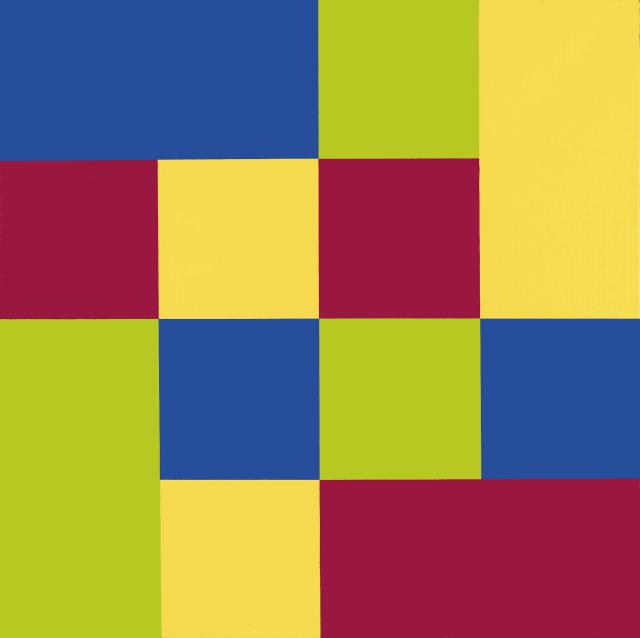Richard Paul Lohse’s geometric painting obeys strict rules that are predetermined by the artist. Each of his compositions is skilfully calculated and structured by his use of drawings before executing the piece. According to Lohse, everything can and must be controlled in a painting, from its elaboration to its realisation. To achieve that, he employs neutral, easily understood forms, which he arranges in a two-dimensional space according to perpendicular lines, whilst taking care to ward off any subjective element.
With Lohse, the work becomes a theorem; in it his method, his way of proceeding, takes shape. The title indicates the system presiding over the design of the canvas, which becomes in turn the illustration of the stated principle. In Gruppe von acht Quadraten mit vier Rechtecken (Group of Eight Squares with Four Rectangles), a similar quantity is used for all the colours and the position of the eight squares, their hues and their alternation with the rectangles is thought of in terms of repetition, variation and equivalence. Vier Gleichen Gruppen mit einem Quadratischen Zentrum (For Equal Groups with a Square Centre) displays a succession of warm and cool tones in a combination that is rhythmically structured by their rotation around a square green core. By placing all the elements in a way that makes their equality clear, the artist obliterates the classic dissociation between content and form.
Lohse’s theoretical reflection inspired Donald Judd to observe, “It’s not the way that Mondrian, Malevich or van Doesburg worked. In Lohse’s work there is the end of the European compositional tradition, a good end, and also there is the beginning of much that is still beginning to develop”.
Starting in 1943-1944, Lohse devoted himself to systematically exploring the themes that he called “modular orders” and “serial orders”, which help in the structural organisation of the surface. The artist saw in his serial compositions models of democratic organisation: all the elements there are interlinked, independent and equal. His paintings and silkscreen prints are, as it were, utopias representing in an exemplary manner an ideal democratic social order in which all individuals enjoy the same rights.
With Lohse, the work becomes a theorem; in it his method, his way of proceeding, takes shape. The title indicates the system presiding over the design of the canvas, which becomes in turn the illustration of the stated principle. In Gruppe von acht Quadraten mit vier Rechtecken (Group of Eight Squares with Four Rectangles), a similar quantity is used for all the colours and the position of the eight squares, their hues and their alternation with the rectangles is thought of in terms of repetition, variation and equivalence. Vier Gleichen Gruppen mit einem Quadratischen Zentrum (For Equal Groups with a Square Centre) displays a succession of warm and cool tones in a combination that is rhythmically structured by their rotation around a square green core. By placing all the elements in a way that makes their equality clear, the artist obliterates the classic dissociation between content and form.
Lohse’s theoretical reflection inspired Donald Judd to observe, “It’s not the way that Mondrian, Malevich or van Doesburg worked. In Lohse’s work there is the end of the European compositional tradition, a good end, and also there is the beginning of much that is still beginning to develop”.
Starting in 1943-1944, Lohse devoted himself to systematically exploring the themes that he called “modular orders” and “serial orders”, which help in the structural organisation of the surface. The artist saw in his serial compositions models of democratic organisation: all the elements there are interlinked, independent and equal. His paintings and silkscreen prints are, as it were, utopias representing in an exemplary manner an ideal democratic social order in which all individuals enjoy the same rights.
